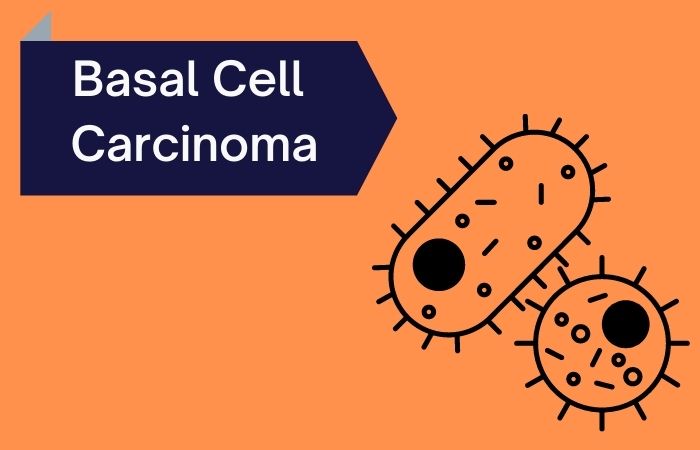Do you know that our skin is the largest organ in our body? Naturally, this makes it more prone to diseases and even skin cancers. One such skin cancer is Basal Cell Carcinoma or BCC. Every year more than 10 million people suffer from this type of skin cancer.
8 out of 10 cases of skin cancer are of basal cell carcinoma cancer all across the globe. This is a non-melanocytic skin cancer that takes place due to sun exposure. The main reason for this type of cancer is when the basal cells under the skin cells mutate their DNA.
To get an effective basal cell carcinoma treatment, it is important to first identify its symptoms. So, read on to understand all about the basal cell carcinoma symptoms and its risk factors.
What is Basal Cell Carcinoma?
Basal Cell Carcinoma is one of the most common types of skin cancers. It generally grows on the most sun-exposed parts of your body, such as the face and neck. Although the term cancer is a dreadful term, with a basal cell carcinoma, the risk is less provided you catch its early signs. Also, note that this type of skin cancer is rare to spread from one part to another part of the skin.Types of Basal Cell Carcinoma
Basal cell carcinoma is a painless type of cancer, which is vivid only in its appearance. Moreover, this is a type of cancer that is categorized in different forms depending on its appearance and these types are:- Superficial Basal Cell Carcinoma: This type of BCC shows a red, flat, and scaly patch on the skin. It generally takes place on the chest or the back.
- Pigmented Basal Cell Carcinoma: This particular type of BCC forms black, blue, or brown lesions on the skin with a defined and raised border.
- Morpheaform Basal Cell Carcinoma: One of the rarest forms of BCC, this type of skin cancer is a white and waxy appearance with no border.
- Basosquamous Basal Cell Carcinoma: This form of BCC is a mix of squamous cell carcinoma and basal cell carcinoma. It is a rare condition and bigger as compared to other forms of BCC.
- Nonulcerative Basal Cell Carcinoma: This type of BCC appears like a white, pink, or skin-colored bump on the skin. It generally appears on the face, neck, and ears.
Causes of Basal Cell Carcinoma
Skin cancers like Basal Cell Carcinoma or BCC are known to occur due to excessive sun exposure and harmful ultraviolet rays. Besides, the other common causes of this skin cancer are:- Fair Skin and Deficiency of Melanin
- Radiation Exposure
- Arsenic Exposure
- Infections, Tattoos, and Vaccinations
- Chronic Inflammatory Skin Disorders
Basal Cell Carcinoma Symptoms
Talking about Basal Cell Carcinoma symptoms, it usually starts as a small bump that shines usually on the nose or any other part of the face. Those who have less melanin and fairer skin are more prone to suffer from this type of skin cancer. Some of the common symptoms of basal cell carcinoma are:- Shiny Small Bumps
- Redness
- Loss of Skin Color
- Blue, Black, or Brown Lesion with Dark Spots
- Swollen Blood Vessels in the Skin
- Ulcers
- Flat and Scaly Patch
- Waxy and White Scar Type of Lesion with a Defined Border
6 Best Basal Cell Carcinoma Treatment for Skin Care
Basal Cell Carcinoma Removal is believed to be the most common treatment for this type of skin cancer. However, there are other treatments too and the choice of basal cell carcinoma treatment will depend on the severity of cancer, its stage, the health, and age of the patient. Some of the treatment options for BCC are:- Surgical Removal: A doctor may prescribe surgical removal for BCC. There are two types of surgical removals for this cancer and they are Mohs Surgery and Excisional Surgery.
- Scratching Off: Second common treatment for this type of skin cancer is scratching off the tumor with a curette instrument, which is then burned with a special electric needle. The term used for this method is called curettage and electrodesiccation.
- Photodynamic Therapy or PDT: In this treatment, a blue light along with a light-sensitive agent is applied to the skin.
- Cryosurgery or Cryotherapy: This is a freezing treatment for basal cell carcinoma removal.
- Laser Treatment: Laser therapy removes or destroys cancerous cells and abnormal cells with the potential to become cancerous using a powerful, narrow beam of light.
- Radiation Therapy: Radiation therapy (also known as radiotherapy) is a cancer treatment that uses to kill cancer cells and shrink tumours, intense doses of radiation are used.
Risk Factors for Basal Cell Carcinoma
Strangely, this type of skin cancer affects men more than women. Moreover, it is usually seen in older people than in younger ones. People with white skin are also at a higher risk of suffering from BCC or Basal Cell Carcinoma.Besides, the following factors may put you at a higher risk of Superficial Basal Cell Carcinoma:
- A Lot of Sun Exposure
- Age
- Immune Suppressing Drugs
- Family History of Skin Cancer
- Inherited Syndromes
- Skin Prone to Freckles and Burns
- Living in Sunny Locations or Higher Altitudes
Basal Cell Carcinoma Prevention Tips
One may reduce the chances of getting infected with this type of skin cancer by following these prevention tips:- Avoiding Mid-Day Sun Exposure
- Wearing Sunscreen
- Wearing Protective Clothing
- Avoid Skin Tanning
- Check Your Skin Regularly for Changes


